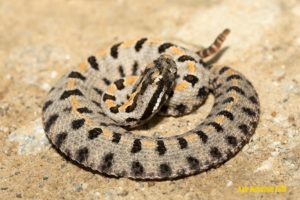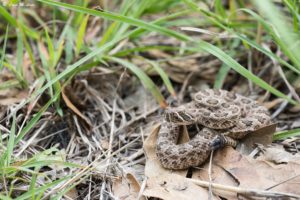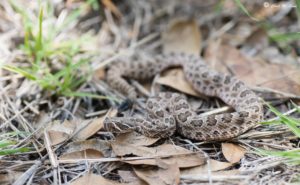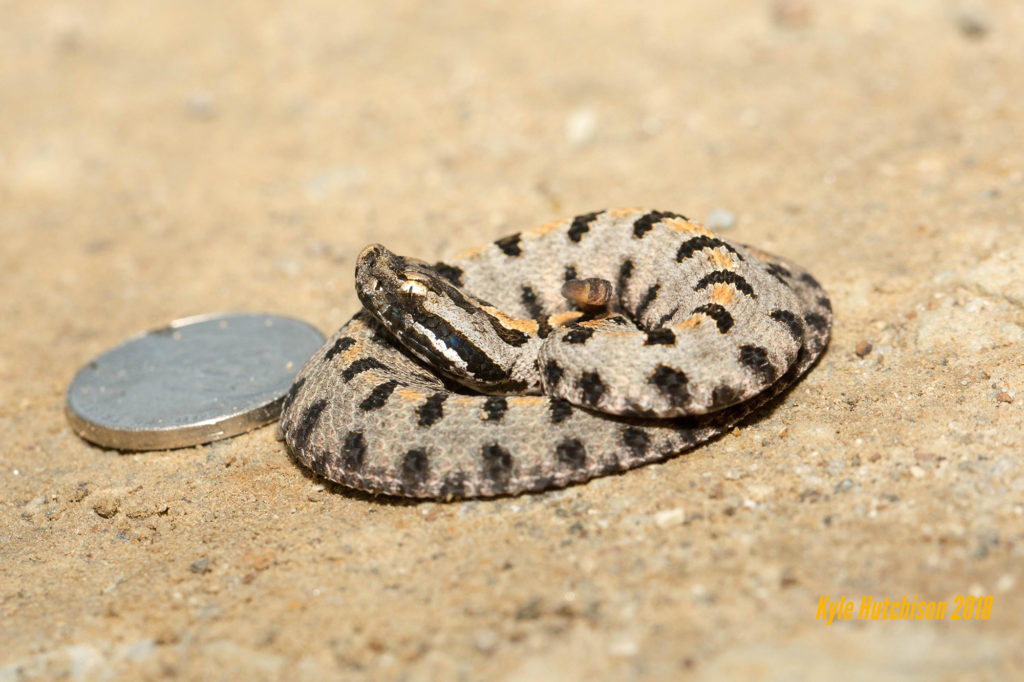
Contrary to popular belief, the bite of a baby rattlesnake is almost always far less serious than the bite of a larger adult rattlesnake. The notion that baby rattlesnakes cannot control the quantity of venom injected (referred to in the field of Herpetology as “venom metering”) is a myth that has been disproven multiple times through well-designed studies. See this excellent paper by the esteemed rattlesnake venom researcher Dr. Bill Hayes for evidence of this fact:
Hayes WK. Venom metering by juvenile prairie rattle- snakes (Crotalus v. viridis): effects of prey size and experience. Anim Behav. 1995;50:33–40.
In any snakebite, the severity is determined by a combination of different factors: those related to the snake that just bit you, and those related to your unique biology, your medical history, and the circumstances surrounding the bite. The outcome of a bite is determined by the aforementioned factors in addition to the speed of the treatment sought by the patient and the appropriateness of the treatment given by the medical team. The answer to the question of whether baby rattlesnakes are more dangerous than adults lies primarily on the snake-related side of the equation. The pertinent snake factors for this question fall into two categories: the composition of the venom and the quantity of venom injected into the patient.

Venom Composition: Venom has two primary roles in rattlesnakes: taking down prey and kick-starting the digestive process. It can be argued the defensive benefits of a venomous bite in these snakes are an unintended, albeit useful, biological bonus. It is important to evaluate rattlesnake venom in the context of the predator-prey relationship. There are over 100 different active components in the venom of a single rattlesnake, all of them targeting different things. As a rough generalization we can categorize venom proteins as either low molecular mass (LMM) neurotoxins (often PLA2s in rattlesnakes) or high molecular mass (HMM) enzymes (often metalloproteases in rattlesnakes) that tear through the blood and soft tissue causing pain, swelling, bleeding, and necrosis. PLA2 fall somewhere between LMM and HMM venom molecules in both size and clinical effects, and they are widely distributed in the venoms of rattlesnakes and various other species. Cobras, mambas, and coral snakes are a few examples of deadly snakes with potent LMM neurotoxins; bites from these snakes can lead to death by respiratory arrest due to paralysis of the muscles involved in breathing and often have the potential to kill you much faster than a purely tissue-destructive venom. Venom composition within a single species of snake varies by age, diet, geographic location, how long ago the snake ate, etc. Different types of venoms are more or less effective at rapidly immobilizing different types of prey (i.e. rodents and ground squirrels vs frogs and lizards).
Venom Quantity: The primary factors that determine the quantity of venom injected are the size of the snake, circumstances of the bite (i.e. a snake that is stepped on is likely to inject more venom than one that is trying to get you to back off), and to some degree whether the bite was to bare skin or through clothing (and what material the clothing was). There is a significant body of compelling research indicating that the size of the rattlesnake, and therefore the quantity of venom injected, is the most important determining factor of the severity of an envenomation. Bigger snakes tend to cause worse envenomations.

Putting it all together: To answer this question, let’s look at these factors in the context of baby versus adult rattlesnakes. Numerous studies have demonstrated that there are significant ontogenetic (age-related) differences in venom composition within a single species of rattlesnake. Young rattlesnakes have a venom that is rich in LMM toxins and low in HMM enzymes, while most adult rattlesnakes have a venom that is predominately composed of HMM tissue destructive enzymes. Baby rattlesnakes eat quick and agile animals like lizards and frogs, which seem particularly sensitive to fast-acting neurotoxins and consequently don’t manage to make it very far away before dying from the venom. Larger rattlesnakes usually eat mammalian prey (rodents and ground squirrels) with significantly more volume-to-surface area than a lizard or frog and likely benefit from the digestive properties of the venom since they will have the whole prey item sitting in their GI tracts for a while. It could be argued that the drop-for-drop potency of baby rattlesnake venom is greater, but here is where the issue of venom quantity comes into play. An adult rattlesnake produces, stores, and injects anywhere from 20–50x more venom (more sometimes, but let’s play this conservatively) than a baby. In this case, the huge increase in total quantity of venom injected has a much greater clinical effect on humans. Clinical evidence supports this, with strong correlations between the size of the rattlesnake and the severity of the bite (see below). It is therefore safe to say that the overwhelming majority of the time, adult rattlesnakes produce more serious envenomations than their younger counterparts.
Here are two of the many good articles to demonstrate that fact:
Hayes WK, Bush SP, Herbert SS, Rehling GC, Cardwell MD, Dugan EA. Defensive bites by rattlesnakes (genus Crotalus): venom expenditure, envenomation severity, and the importance of snake size. In: Program and Ab- stracts of the Biology of the Rattlesnakes Symposium. Loma Linda, CA: Loma Linda University; 2005:31.
Wingert WA, Chan L. Rattlesnake bites in southern California and rationale for recommended treatment. West J Med. 1988;148:37–44.
The takeaway is that while adult rattlesnakes are more likely to cause worse envenomations, a bite from a baby rattlesnake is no joke and can still kill you if you don’t get proper medical treatment. This is especially true in cases involving children due to their smaller masses. Treat all snakes with respect, give them a wide berth, and appreciate them for doing an excellent job of keeping rodent populations under control. Rattlesnakes have no interest in biting humans and we are fortunate to have a species of venomous snake that gives us fair warning before striking, so respect that fact and appreciate them from a distance.
